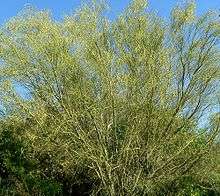Parkinsonia microphylla
| Parkinsonia microphylla | |
|---|---|
 | |
| Scientific classification | |
| Kingdom: | Plantae |
| (unranked): | Angiosperms |
| (unranked): | Eudicots |
| (unranked): | Rosids |
| Order: | Fabales |
| Family: | Fabaceae |
| Subfamily: | Caesalpinioideae |
| Tribe: | Caesalpinieae |
| Genus: | Parkinsonia |
| Species: | P. microphylla |
| Binomial name | |
| Parkinsonia microphylla | |
 | |
| Natural range | |
| Synonyms | |
|
Cercidium microphyllum (Torr.) Rose & I.M. Johnst. | |
Parkinsonia microphylla, the yellow paloverde, foothill paloverde or little-leaved palo verde; syn. Cercidium microphyllum), is a species of palo verde.
It is native to the Southwestern United States in southeastern California and southern Arizona; and to northwest Mexico in the states of Sinaloa, Sonora, and Baja California. The plant is mostly found on slopes, and is one of the most common trees of the Sonoran Desert.
Description
Parkinsonia microphylla is a bristling, upright-branching tree. The species is slow-growing, sometimes living for several hundred years. It typically grows to heights of around 5 metres (16 ft), although rarely it can reach 6–7 metres (20–23 ft) tall.
The leaves are yellowish green, and during extensively dry and hot periods the tree will shed them. It has the characteristic of performing photosynthesis in its bark (hence the green color), and this is what allows it to survive leafless in hotter periods.
The flowers are found on the end of a branch, small, pale yellow and occur in late spring. The tree may not flower every year, depending on the amount rainfall. If there is enough rainfall, seeds will also appear in 4–8 cm long, soft pods which dip in between each seed. They ripen in July, and stick to the branches. Rodents will often carry and store the seeds underground, where some of them will germinate after a rainy season.
The seedlings are very sensitive to drought for the first two to three months of their lives, and only about 1.6% will survive after germinating.
- Threats
Buffelgrass is an exotic species of grass native to Africa, first introduced into the Sonoran Desert for livestock grazing, which spreads very quickly and can often kill seedlings by using available water, which could be a threat in the future.
Uses
The Seri people, a Native American group of northwestern Mexico, call this tree ziipxöl [ʃiːpχʷɬ]. They used to grind up the seeds for flour, boil the green pods with meat, and eat the sweet green seeds as well as the flowers. They also strung the seeds for necklaces.
Cultivation
Parkinsonia microphylla is cultivated as an ornamental tree for use in xeriscapic, modernist, and native plant gardens. It is also used as a small tree in parking lot plantings of commercial developments.
Gallery
- Foothill Palo Verde pictured near the Superstition Mountains (Arizona)
 Flowers
Flowers- Saguaro and Palo Verde forest, Ironwood Forest National Monument
References
- "Parkinsonia microphylla". Germplasm Resources Information Network (GRIN). Agricultural Research Service (ARS), United States Department of Agriculture (USDA).
- Felger, Richard; Mary B. Moser. (1985). People of the desert and sea: ethnobotany of the Seri Indians. Tucson: University of Arizona Press.
- Pavek, Diane S. (1994). "Parkinsonia microphylla". Fire Effects Information System (FEIS). US Department of Agriculture (USDA), Forest Service (USFS), Rocky Mountain Research Station, Fire Sciences Laboratory – via https://www.feis-crs.org/feis/.
External links


- "Parkinsonia microphylla". Natural Resources Conservation Service PLANTS Database. USDA.
- Jepson Manual: Parkinsonia microphylla
- Cercidium microphyllum in the CalPhotos Photo Database, University of California, Berkeley